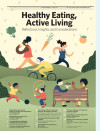 (Illustration by Chiara Zarmati)
(Illustration by Chiara Zarmati)
McDowell County, located in North Carolina’s southern Appalachian Mountains, is overwhelmingly white. African-Americans are approximately 4 percent of the population, and less than 3 percent of residents are Latinx. McDowell’s county seat, Marion, is no less stratified, and this uneven population distribution has historically led to lopsided power imbalances in the region. People living in the predominantly black section of West Marion say that their community was often the last to see plows after a snowfall. Substandard housing proliferated and fresh food was scarce.
Healthy Eating, Active Living

This collection of articles, produced for Grantmakers In Health and supported by the Colorado Health Foundation, explores the latest thinking from health funders, researchers, and advocates on healthy eating and active living (HEAL) and healthy communities.
-
Healthy Eating, Active Living: Reflections, Insights, and Considerations for the Road Ahead
-
Healthy Eating and Active Living Through an Equity Lens
-
Connecting Health and Education So Children Can Learn and Thrive
-
The Future of Healthy Eating Research
-
How to Improve Physical Activity and Health for All Children and Families
-
The Colorado Health Foundation’s HEAL Evolution
-
How Market Forces Could Improve How We Eat
-
The Power of Business to Change Food Culture for the Better
-
Political Power as a Tool to Improve the Health of All Americans
-
Evaluate, Invest in Advocacy, and Shrink the Change
Community leaders in West Marion were tired of being treated like second-class citizens. So they started holding community conversations at a small local church to discuss these disparities and how they might upend the status quo. One of the first projects they undertook was the founding of a community garden.
The Kate B. Reynolds Charitable Trust, based in Winston-Salem, works statewide to improve the health and quality of life of financially disadvantaged residents, and since 2012 it has partnered closely with McDowell County through the Healthy Places NC initiative. With Healthy Places NC, Trust staff spend time in underserved rural areas like McDowell County to gain a greater understanding of how to address the health needs of marginalized populations.
When we started Healthy Places NC, we didn’t know which way the trail would bend. But over the past six years, we have learned a great deal about how to invest in rural regions. We understand that to do this work well, new voices, like those of the West Marion residents, must be heard at decision-making tables. The West Marion community conversations and the garden were the beginning of elevating those voices in McDowell County.
As president of the Trust, I also bring my own background to the work. I was raised in rural North Carolina, in one of the most economically distressed communities in the country. I started my career as a pediatrician in my hometown, and I have since served in various leadership roles aimed at improving population health, including a tenure as state health director. This experience taught me that to change harmful trends, you must first name what you are trying to accomplish. For us, that goal is equitable health outcomes.
Through the Trust’s Healthy Places NC initiative, we are doing long-term, community-driven health-improvement work in 10 rural counties. Each of these counties identifies healthy eating and active living as key focus areas. To meet this need, we have invested in playgrounds, walking trails, community gardens, farmers’ markets, and parks.
What we continue to ask ourselves is, how do we leverage the excitement and momentum in these counties around healthy eating and active living to advance equitable health outcomes and decrease long-standing disparities? My own experience, and the experience of the Trust, point to some preconditions and values that can advance our shared interest in building thriving places to live and play, especially for those with the greatest needs.
Listening and Transparency
As a clinician, I learned the power of listening to patients and allowing them to help shape the course of their own treatment. A physician lecturing a patient to lose weight is unlikely to inspire change. The same is true of a foundation deciding, based on surveys and statistics, that a community should reduce its overall rates of obesity. So we start by listening, and we pay particular attention to the voices of the people most affected by poor health outcomes. Working toward a collective goal encourages partnerships, rallies residents, builds momentum, and has a greater likelihood of addressing issues underpinning inequity in health.
Transparency is also critical to building authentic relationships in the places we serve. This is why we seek to get clear, both internally and externally, about what foundations can offer healthy eating and active living initiatives. Our organization is guilty of starting expensive, intensive programs without first considering scale and sustainability and without adding comprehensive evaluation. We can’t perpetually support efforts that help a few people in a few places. But if we reallocate funding without providing nonprofit partners with the proper tools, people will feel abandoned, and our impact will be ephemeral.
Support Community Capacity
Foundations often find that communities starved of resources lack the organizational infrastructure to seek grant funds. The Trust employs several strategies for addressing this challenge. We contract with an intermediary organization that provides networking, facilitation, and organizational development services for the under-resourced communities. We partner with grassroots capacity-building groups such as Resourceful Communities, a project of the Conservation Fund, to build networks and provide small grants to new or small nonprofits. We also work with larger organizations that can serve as fiscal agents as marginalized communities form nonprofits and develop the proficiency and framework to pursue funding. We sometimes mediate the relationships between existing institutions and nascent community organizations to ensure that these fledgling groups based in marginalized neighborhoods have the autonomy they need to grow and succeed.
This is the path we pursued in West Marion. As the community established a nonprofit, West Marion Community Forum, we worked with a local health coalition and the city to provide the nonprofit with financial support. We contracted with technical assistance partners to assist the people of West Marion with communications and adaptive leadership. Now the neighborhood that started regular gatherings and developed a community garden has its own nonprofit that is attracting funds from several sources to mobilize financially disadvantaged residents.
Intervene at the Systems Level
Some of the rural counties we serve in North Carolina have the highest rates of obesity and chronic disease in the state. Foundations and public health agencies have spent enormous amounts of time and money trying to “program” us out of these problems. Despite this work, the percentage of overweight adults and adolescents continues to climb. Something about our current strategy isn’t working.
We’ve found that the best place for philanthropy to intervene is at the systems level, changing the contexts that shape the way people live and recreate. This approach can take many forms. Foundations can help communities make better-informed and more equitable decisions by extending technical assistance, content expertise, data analysis, and outcomes monitoring. We can also responsibly build the capacity of grassroots organizations, especially organizations led by people of color, to participate in health campaigns. We can encourage creative partnerships and fund public education and advocacy on select topics or finance the development of effective messages.
One example: Halifax County is in northeastern North Carolina. The population is 53 percent black, approximately 40 percent white, about 4 percent Native American, and 3 percent Latinx. When the Trust launched Healthy Places in Halifax, parks and playgrounds were not equitably distributed. A few larger towns had recreation resources, but there was little countywide planning. The Trust helped public schools across Halifax upgrade playground equipment and walking trails with the stipulation that they open these facilities to the community after hours and on weekends. We helped finance a county master recreation plan, which included support for facilitation and engagement to ensure that traditionally marginalized voices played a central role in shaping the plan. We also provided general operating support for grassroots groups that educated residents about the recreation plan and about the importance of a county-level recreation department.
We believe that efforts to address community context, to go beyond just one program or a single playground, hold the greatest potential to make an enduring difference. That is not to say that programs aren’t important for healthy eating and active living. When we invest in programs, however, we need to evaluate the evidence to increase the likelihood that we will see the desired results. We also must grasp the scale of the intervention and gauge it against the size of the need. During implementation, we should help build relationships with the government entities, health systems, or insurance companies that have an interest in continuing activities that improve population health and lower costs. Philanthropy can spark innovation by nurturing new ideas or pilot programs. In these cases, we should support evaluation to understand the successes and shortcomings of the project.
Focus on Outcomes
In all of our work, we must keep an eye on results. Because our aim is equitable health outcomes, we have an obligation to understand if our actions are narrowing or widening disparities. Opening school facilities on weekends may be good policy, but if communities of color feel unwelcome in these spaces, then black and Latinx children may not use these recreation resources. Well-intentioned policy changes can have unintended consequences that may negatively impact low-income populations.
I offer these recommendations because, after spending my career improving population health, I am convinced that what has gotten us to where we are will not deliver us to where we want to go. Again, we make no claim to omniscience. Our organization is still learning along with our colleagues inside and outside of philanthropy. But I feel confident that we are on the right course.
In McDowell County, where the people of West Marion started small community conversations that grew into well-attended meetings, change is afoot. These gatherings now attract city council members, county commissioners, and city planners. This section of the city, which was once the last to be cleared of snow, is now one of the first areas to see plows. We are now supporting the spread of this engagement model to other underserved areas of the county.
This work can seem overwhelming. But a hopeful note about changing current conditions is that systems are always shifting. The status quo requires maintenance. Policies are in a constant state of flux, and communities are always being made and remade. If we listen and build authentic relationships, we can find the fulcrums that will direct our state toward greater equity and fairness.
Support SSIR’s coverage of cross-sector solutions to global challenges.
Help us further the reach of innovative ideas. Donate today.
Read more stories by Laura Gerald.

